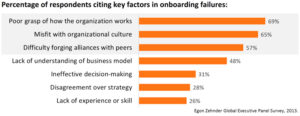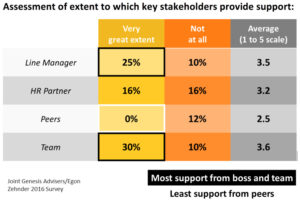
Does your company really do a good job of onboarding new hires?
In “Onboarding Isn’t Enough,” a recent Harvard Business Review article I co-authored with Mark Byford and Lena Triantogiannis from Egon Zehnder, we showed that many companies think they are doing a good job of onboarding newly-hired executives when they actually aren’t.
This is important because new executives who fail or underperform (up to 40% according to some studies) impose very high direct costs (recruiting, and salary) and indirect costs (lost opportunities to turnaround, sustain, and grow businesses) on the companies who hire them.
Why aren’t companies doing a good job in executive onboarding? Because (1) there has been no good definition of what “excellent onboarding” actually involves, (2) the real reasons why newly-hired executives fail or underperform have to do with political and cultural integration challenges for which few company onboarding systems provide support, and (3) this support is best provided by transition acceleration advisors that have specialized skills, not by the leadership development coaches used by many organizations.
Why new hires fail or underperform
In 2013, Egon Zehnder surveyed more than 500 experienced executives, exploring why new hires struggled when onboarding. The results, summarized below, showed that the biggest reasons were about politics and culture, not competence or experience. Executives failed when they didn’t understand “the real rules of the game” and/or failed to build critical relationships, especially with peers.

The importance of peers was validated in a subsequent survey of onboarding executives conducted jointly by Genesis Advisers and Egon Zehnder in 2016. The newly-hired leaders were asked to assess the degree to which they received support from key stakeholders, including their hiring managers, teams, and HR business partners. The results, summarized below, showed that they received the least support from peers. The implication is that while failure to build effective working relationships with peers is one of the biggest reasons for onboarding failure, newly-hired leaders can’t expect their peers to spontaneously provide them with support.

Cultural adaptation and political connection are, of course, very difficult challenges for newly-hired executives to meet on their own. Figuring out how to operate in a new cultural/political system without support is like sailing through dangerous waters in a fog without radar, sonar, or GPS. The implication is that company onboarding systems that don’t explicitly support new hires in integrating, by adapting to the culture and building critical relationships, are setting them up to fail.
What (many) company onboarding systems don’t do
Given that it’s so important to help new hires integrate effectively, it’s surprising that few companies, even large global ones, do a good job. A series of surveys of senior HR executives conducted jointly in 2015/16 by Genesis Advisers and Egon Zehnder, summarized below, showed that most companies did a good job of getting new hires into the company but few helped leaders integrate into the culture and build critical relationships.
Percentage of senior HR leader assessing their organizations as being effective in key dimensions of onboarding and integration:

The direct and opportunity costs of failure or underperformance by outside hires are very high, and studies have shown executive onboarding failure rates of 25 to 40%. This is a surprising finding. One explanation is that senior management (including HR leadership) don’t understand that what they are doing for “onboarding” today isn’t sufficient. Other explanations including “sink-or-swim” cultures that discourage providing support for leaders in transition—I call this leadership development through Darwinian evolution—and a lack of clarity for who is responsible for integrating new leaders. On the latter issue, recruiting and talent acquisition groups are often responsible for getting leaders onboard but not for getting them integrated and fully up to speed.
To assess the effectiveness of onboarding systems, we created an online Organizational Onboarding Effectiveness Assessment which is available free of charge. Use it to see how your company rates relative to the global sample of companies we studied.
Key takeaways
The research provided rich insight into the limitations of many companies’ existing executive onboarding systems. So, start by assessing how well your company is doing today by using the Organizational Onboarding Effectiveness Assessment.
If your company has a weak system for onboarding and integration, evaluate potential ways to strengthen it, looking specifically at the benefits of providing newly-hired executives with transition acceleration advisors—either by training HR business partners/internal consultants or by engaging with external providers.
Michael D. Watkins is Professor of Leadership and Organizational Change at IMD. He directs the First 90 Days, for leaders in transition. He co-directs Transition to Business Leadership (TBL), a program designed for experienced functional managers who either have recently transitioned or will soon transition into a business leadership position.
Research Information & Knowledge Hub for additional information on IMD publications

Taking up a new leadership post can mean a dramatic shift in the way others see you – and how you define yourself. It is vital to learn how to separate your true self from the demands and expectations of the role.
Gen AI may herald a significant shift in remote work hiring patterns. As it continues to bridge gaps in the output quality of knowledge work, the cost advantage of hiring foreign workers becomes increasingly attractive. The leveling-up effect of g...
This note presents an integrated model for organizational culture transformation, addressing common pitfalls and barriers to successful change. It outlines seven key elements: (1) defining the target culture, (2) clarifying leadership’s role, (3) ...

While the dynamic, purpose-filled nature of startups is a big attraction, Gen Z talent should also consider what more established companies have to offer says IMD’s Lars Häggström.

Here's how to get the most out of your team – even if you're only together for shorter periods of time.
In today’s fast-paced and ever-changing business environment, small and medium-sized enterprises (SMEs) face unique challenges. From navigating market volatility to managing limited resources, SMEs must find ways to build resilience within their t...
Building trust in family-owned companies involves overcoming challenges from overlapping family and business dynamics. Non-family employees often face a “glass ceiling” due to perceived favoritism and limited career growth. Strategies like transpa...
Foxconn, a Fortune Global 500 giant and the world's largest electronics manufacturer, made headlines in 2023 by announcing a shift to a five-day, eight-hour workweek in its Chinese factories - a significant departure from its long history of exten...

Your top talent should come from different disciplines with different experiences to more effectively analyze the strategic environment. Use the IPO model below to see how it can be done.

Culture eats strategy for breakfast is one of the most enduring truisms of management. But is it really the case? And what is culture anyway?
Research Information & Knowledge Hub for additional information on IMD publications
Research Information & Knowledge Hub for additional information on IMD publications
Research Information & Knowledge Hub for additional information on IMD publications
in I by IMD 7 January 2025
Research Information & Knowledge Hub for additional information on IMD publications
Research Information & Knowledge Hub for additional information on IMD publications
Research Information & Knowledge Hub for additional information on IMD publications
Research Information & Knowledge Hub for additional information on IMD publications
Research Information & Knowledge Hub for additional information on IMD publications
Research Information & Knowledge Hub for additional information on IMD publications
Research Information & Knowledge Hub for additional information on IMD publications

